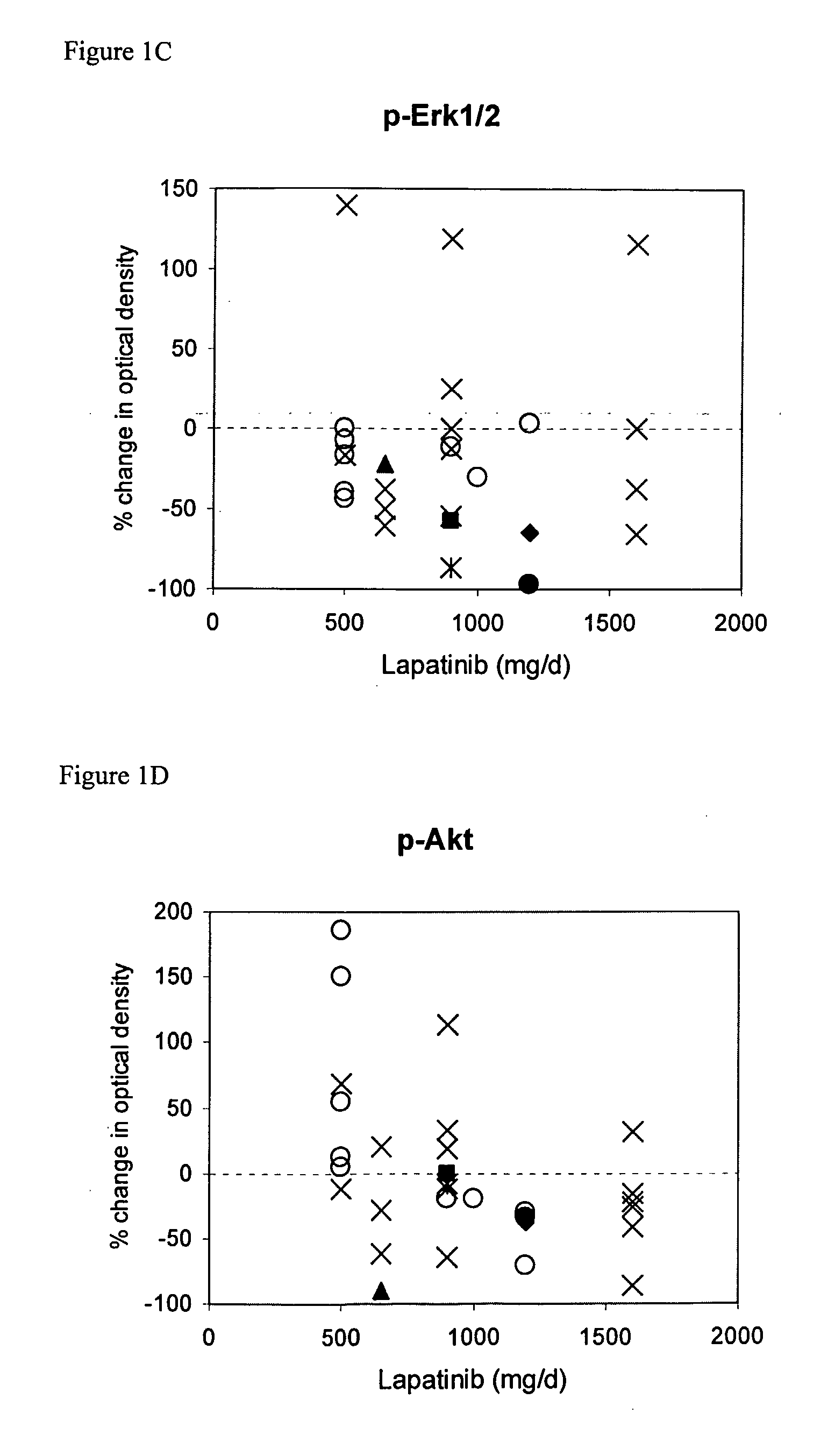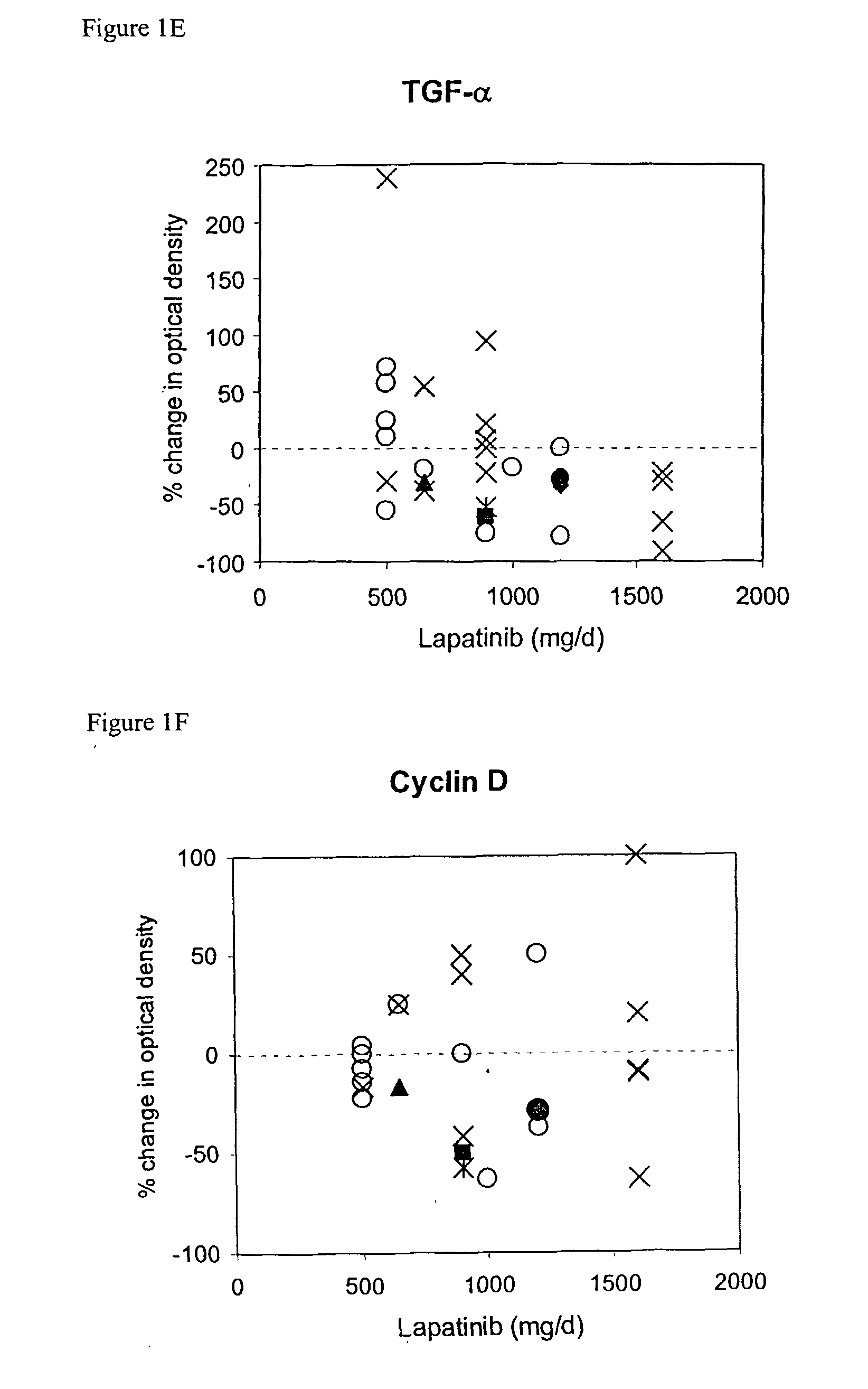Predicitive biomarkers in cancer therapy
a cancer therapy and pretreatment technology, applied in the field of biomarkers, can solve the problems of non-specificity of many existing anti-cancer chemotherapeutics, damage or kill normal cells, etc., and achieve the effect of increasing the pretreatment level
- Summary
- Abstract
- Description
- Claims
- Application Information
AI Technical Summary
Benefits of technology
Problems solved by technology
Method used
Image
Examples
example 1
Subjects and Methods
Clinical Study Design
[0067] The Institutional Review Boards at the Sarah Cannon Cancer Center, University of North Carolina-Chapel Hill / Lineberger Comprehensive Cancer Center, Duke University Medical Center, and Case Western Reserve Medical Center approved this study. Patients providing informed consent were enrolled on this open-label, randomized trial if their tumors (i) overexpressed ErbB2 and / or ErbB1 (2+ to 3+ IHC staining in >10% of tumor cell, or (ii) demonstrated ErbB2 gene amplification by FISH. Additional eligibility criteria included the following: age ≧18 years; measurable metastatic solid malignancies not amenable to established standard therapies; Karnofsky performance status ≧70; no prior chemo-, radio-, hormonal or immunotherapy within the previous 4 weeks; LVEF ≧40%;_Hgb ≧9 g / ml; ANC ≧1,500 / mm3; platelet ≧100,000 / mm3; total bilirubin ≦2.0 mg / dL and transaminases ≦3×ULN unless due to tumor.
[0068] Patients were randomized to one of five dose co...
example 2
Subjects and Sequential Tumor Biopsy Specimens
[0077] Demographics of the 33 patients are shown in Table 1. Expression of ErbB1, ErbB2, p-ErbB1, p-ErbB2, Erk1 / 2, p-Erk1 / 2, Akt, p-Akt, TGFalpha, IGF-IR and cyclin D1 was assessed by IHC with automated image analysis using established assays; OD values were assigned to each specimen. TUNEL scores represent the percent tumor cells staining positive. Day 21 biopsy specimens were obtained within 4 to 12 hours following lapatinib dosing to maximize the probability of detecting a biological response. Clinical responses, safety profile, and pharmacokinetics for this study have been previously reported (Spector et al., Proc Am Soc Clin Oncol 22: 772a (2003); Koch et al., Eur J Cancer 1 (suppl 5): 559a (2003)).
example 3
[0078] This study analyzed Phase I clinical trial data, analyzed in two subsets (Breast Cancer and Not Breast Cancer). The outcome measures were: clinical status, response duration, and postdose TUNEL %. The Clinical Status was either: Partial Response (PR), Stable Disease (SD), or Progressive Disease (PD). The Response Duration was valued at between 2 and 10 for SD or PR, and valued at 0 for Progressive Disease. The Postdose TUNEL % was used for classification, with TUNEL %>30 utilized as an indication of apoptosis.
[0079] The dataset included patient demographics, dose of lapatinib, measurements of nine different proteins, and TUNEL (predose, postdose and % change). The nine proteins (EGFR / ErbB1, ErbB2, ERK, AKT, TGFalpha, IGF1R, ribosomal protein S6, Heregulin (NDF), and cyclin D1). Some proteins were assayed in the phosphorylated state (pAKT), while EGFR / ErbB1 and ErbB2 were measured in both phosphorylated and unphosphorylated states.
[0080] The statistical ...
PUM
| Property | Measurement | Unit |
|---|---|---|
| soluble | aaaaa | aaaaa |
| resistance | aaaaa | aaaaa |
| size | aaaaa | aaaaa |
Abstract
Description
Claims
Application Information
 Login to View More
Login to View More - R&D
- Intellectual Property
- Life Sciences
- Materials
- Tech Scout
- Unparalleled Data Quality
- Higher Quality Content
- 60% Fewer Hallucinations
Browse by: Latest US Patents, China's latest patents, Technical Efficacy Thesaurus, Application Domain, Technology Topic, Popular Technical Reports.
© 2025 PatSnap. All rights reserved.Legal|Privacy policy|Modern Slavery Act Transparency Statement|Sitemap|About US| Contact US: help@patsnap.com



